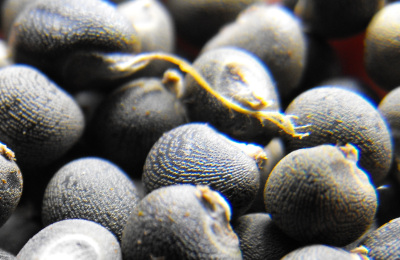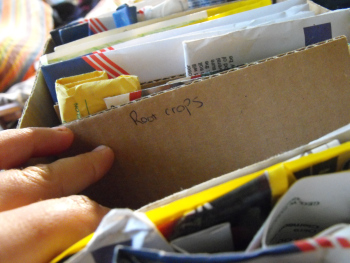
Introduction to Seed Saving
 Many homesteaders save seeds because they
don't trust the big companies to keep producing varieties they care
about. Skinflints like me save seeds because seed prices have
been skyrocketing in the last couple of years. Whatever your
reasoning, saving seeds can be pretty painless if you understand a bit
of plant biology.
Many homesteaders save seeds because they
don't trust the big companies to keep producing varieties they care
about. Skinflints like me save seeds because seed prices have
been skyrocketing in the last couple of years. Whatever your
reasoning, saving seeds can be pretty painless if you understand a bit
of plant biology.
First of all, let me say up front that we don't save all of our seeds
--- we basically stick to the really easy species. Some types of
vegetables --- like carrots and onions --- are just not worth bothering
with since they are biennials and take two years to mature and produce
seed. Other types of veggies, like lettuce, have seeds that I
find hard to catch and harvest at the right time.
Even within certain vegetable species, some varieties are much easier
to save than others. Many of the varieties you'll pick up at the
local feed store or big box store are hybrids, produced by mating two
different types of plants together. Gardeners are often impressed
by hybrids because of hybrid vigor --- the tendency of hybrid offspring
to be bigger and sometimes better than either of their parents.
Unfortunately, if you save seeds from a hybrid, your seeds will sprout
into plants that all look different and that often are not as exciting
as the hybrid you started with. If you want to save seeds, look
for varieties marked as heirlooms --- these varieties will breed true,
with your seeds sprouting into plants just like their parents.
 The rest of this week's lunchtime series will
explain how to save seeds from some easy vegetable varieties. But
before you go, a couple more words of wisdom. First of all, you
won't need to save seeds every single year --- many seeds
last up to five years, so you can easily skip a season or two and
your seeds will still sprout. Second, most places recommend that
you store your seeds in an airtight container, but I have to admit that
I'm lazy and just throw my homemade paper packets into a cardboard box,
with no ill effects. I do put in dividers, though, and sort the
seeds by plant family and growth habit so that I know what I've got.
The rest of this week's lunchtime series will
explain how to save seeds from some easy vegetable varieties. But
before you go, a couple more words of wisdom. First of all, you
won't need to save seeds every single year --- many seeds
last up to five years, so you can easily skip a season or two and
your seeds will still sprout. Second, most places recommend that
you store your seeds in an airtight container, but I have to admit that
I'm lazy and just throw my homemade paper packets into a cardboard box,
with no ill effects. I do put in dividers, though, and sort the
seeds by plant family and growth habit so that I know what I've got.
Finally, don't forget the plants that you can reproduce without
resorting to seeds. If you have some leftover potatoes next
spring, you can just cut them up and put them in the ground.
Garlic, of course, can be divided into individual cloves and planted in
the fall. This year, we also had great luck with sprouting
our leftover sweet potatoes to make slips. You can do it too!
| This post is part of our Seed Saving lunchtime series.
Read all of the entries: |
Want more in-depth information? Browse through our books.
Or explore more posts by date or by subject.
About us: Anna Hess and Mark Hamilton spent over a decade living self-sufficiently in the mountains of Virginia before moving north to start over from scratch in the foothills of Ohio. They've experimented with permaculture, no-till gardening, trailersteading, home-based microbusinesses and much more, writing about their adventures in both blogs and books.
Want to be notified when new comments are posted on this page? Click on the RSS button after you add a comment to subscribe to the comment feed, or simply check the box beside "email replies to me" while writing your comment.
